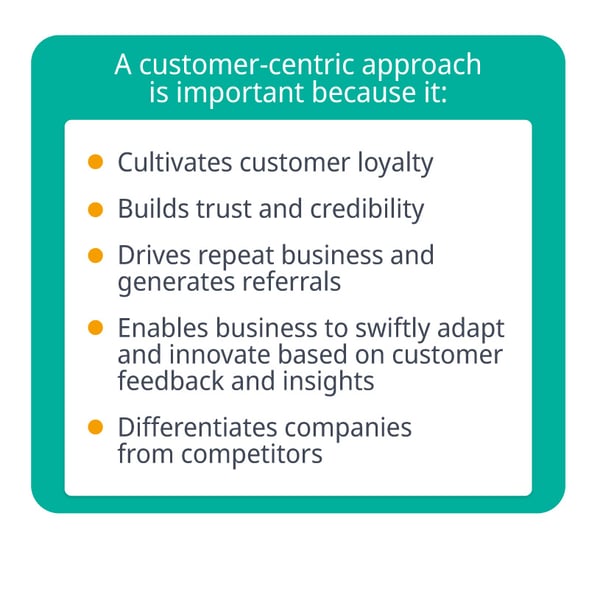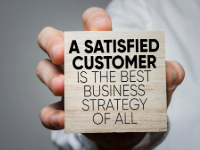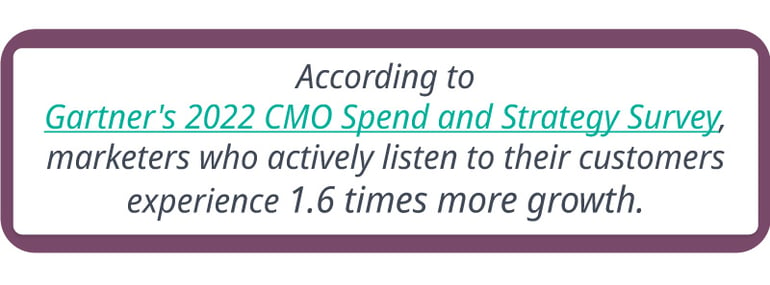Want to stay relevant? The answer is adapting to customer needs.
In any business landscape there is one fundamental truth: without customers a business holds little value. Yet keeping customers engaged presents an ongoing problem in today’s evolving and highly competitive business world. This means that, at a time when attention spans are short and competition is fierce, the ability to truly connect with and satisfy customers becomes a key competitive advantage.
There is no great magic secret to keeping customers engaged and loyal; rather, the answer lies in creating exceptional customer experiences. This is where adopting a customer-centric approach becomes important, characterized by effective communication, consistent Customer Relationship Management (CRM), proactive problem-solving (and solutions!), and the strategic leveraging of real-time data.
Let’s further explore why the customer-centric approach is so important to thriving in the long term, and why the data produced by modern accounting and technology is so important.
Understanding Customer-Centricity
Simply put, a customer-centric approach means prioritizing the customer above all else. It means placing the customer at the heart of any business strategy, integrating customer needs into every aspect of business strategy, operations, and decision-making.
 To achieve this, success goes beyond just products or platforms to delivering value that extends beyond the transactional exchange. It requires a deep understanding of evolving customer needs, preferences, and behaviors then the ability to tailor products, services, and interactions accordingly.
To achieve this, success goes beyond just products or platforms to delivering value that extends beyond the transactional exchange. It requires a deep understanding of evolving customer needs, preferences, and behaviors then the ability to tailor products, services, and interactions accordingly.
However, companies that truly embrace and are committed to customer-centricity don’t stop at surface-level interactions. They strive to achieve a seamless and personalized experience at every touchpoint of the customer journey. The ultimate goal? To build lasting relationships based on trust, loyalty, and respect that turn satisfied customers into enthusiastic advocates who actively support and promote the business.

What Are Different Parts of a Customer-Centric Approach?
Implementing a customer-centric approach involves many factures, including effective communication, nurturing relationships through Customer Relationship Management (CRM), and leveraging data-driven insights.
1. Effective Communication Drives Success
In any customer relationship, effective communication goes far beyond any marketing pitches, sales calls, or simply conveying information back and forth. It entails actively listening, understanding, and responding to customer feedback and concerns. This is especially important in today’s digital age where each day is a new encounter with automated responses and generic messages.

Tailoring and personalizing communications, whether through targeted email newsletters or engaging social media interactions, is crucial. Each interaction should foster a sense of connection and reinforce the company’s value for each customer as an individual.
Furthermore, transparent communication builds trust. Being upfront about product updates, service disruptions, or pricing changes demonstrates integrity and makes customers feel informed and respected. It reassures them that they – and their needs – are a priority for the company.
2. Nurturing Relationship with CRM
Effective Customer Relationship Management (CRM) - the ways that companies manage their customer interactions and data - is essential for improving customer relations, retaining clients, and driving sales.
 While there are many ways to implement a CRM program, dedicated CRM systems in particular are invaluable tools. They excel in centralizing customer data, tracking customer interactions, predicting needs, and customizing offerings.
While there are many ways to implement a CRM program, dedicated CRM systems in particular are invaluable tools. They excel in centralizing customer data, tracking customer interactions, predicting needs, and customizing offerings.
Furthermore, the advantages of CRM extend beyond external benefits. These systems also promote internal collaboration, supporting seamless teamwork across departments. This helps create a cohesive approach that ensures effective customer engagement and problem-solving.
3. Anticipating and Addressing Customer Needs
Truly customer-centric organizations go beyond merely reacting to customer requests; they anticipate and address needs before they even arise. This proactive approach involves identifying potential pain points along the customer journey and implementing measures to eliminate or mitigate them before they even occur.
For example, leveraging predictive analytics and other advanced technologies enables businesses to forecast demand, optimize inventory levels, and identify growth opportunities. Likewise, proactive customer service strategies involve addressing common issues through comprehensive FAQs, tutorial videos, or even chatbots that provide real-time assistance.
By maintaining a proactive approach and staying one step ahead, businesses can achieve more than just build trust, loyalty, and satisfied customers. They can stay ahead of the curve and deliver solutions that consistently surpass expectations.
4. The Power of Data-Driven Decisions
In today’s data-driven world, the adage “knowledge is power” holds truer than ever before. This is particularly true of a customer-centric approach, where data provides businesses with valuable insights into customer behavior, preferences, and pain points. Using this information allows them to deliver tailored experiences that resonate with the customer and achieve maximum impact. .png?width=449&height=386&name=Untitled%20(1).png)
Furthermore, data-driven insights enable businesses to measure the effectiveness of their customer-centric initiatives and adjust accordingly. This ensures that they are always on point when it comes to addressing customer needs, resulting in higher customer satisfaction and a sustained competitive advantage.
In parallel, as business increasingly turn towards digital transformation, modern technologies such as Artificial Intelligence (AI) and Machine Learning (ML) are becoming crucial for accurate real-time data capture and customer responsiveness. In fact, it has become so important that according to the Equinix 2023 Global Tech Trends Survey (GTTS) report, a staggering 79% of IT leaders plan to apply AI to improve customer experience.
The Correlation between Customer Satisfaction and Loyalty
There is a direct relationship between customer satisfaction and long-term relationships. When customers feel valued and understood, with their needs constantly addressed, they naturally develop a sense of loyalty and trust towards the brand.
This strong bond not only fosters repeat business but also creates brand advocates who actively promote and recommend the company to others. Consider the following statistics:
- 80% of customers consider the experience that a company provides to be as important as their product or services.
- Customer-centric companies are 60% more profitable compared to companies not focused on the customer.
- 90% of companies compete solely on the basis of customer experience.
The proof is there, unequivocally supporting the correlation.
Conclusion
In conclusion, embracing a customer-centric approach is more than simply a strategy. Instead, it is the very key to thriving in today’s business landscape. By prioritizing the needs and experiences of customers, companies can forge lasting relationships built on trust, loyalty, and mutual respect.
In a world where customer experience reigns supreme, putting the customer first is the fundamental driver of lasting growth and success.
Ready to automate your finances for real-data that supports a customer-centric approach? Reach out today.









